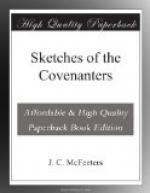A committee was appointed to wait on Weir and investigate his case. They were roughly received. He gave no satisfaction for having been on the enemy’s side on the former occasion. The Covenanters were quick to reach Bible conclusions and at once classed him with Achan who in the days of Joshua brought defeat upon Israel. Weir with his detachment was summarily dismissed. A resolution was then adopted that none, who had forsaken the Covenant or were guilty of the sins of the times, be admitted into the army. This was a heroic step, a return to the solid basis, the old Covenant grounds that had been abandoned in 1650, when the “Act of Classes” was rescinded, and the doors opened to admit unfaithful men into places of public trust. Sir Robert Hamilton, at the head of half a regiment of Covenanters, thus nobly attempted to rebuild the walls of Zion and set up the gates, even in troublous times. These were men of God who knew the Lord of hosts, in whose eyes fidelity is everything and numbers are nothing. They were afraid of nothing but sin.
The martial spirit of the Covenanters rapidly spread during the week; they flocked to the standard that was again lifted up for Christ’s crown and covenant.
Beneath the waving folds of the Blue Banner 5,000 men had rallied when Saturday’s sun was sinking in the west. They had unbounded confidence in the cause for which they adventured their lives; a holy enthusiasm knit them together. They were ready for battle “with hand strokes,” as they said to Hackston, one of their noble captains. They had accepted the responsibility of war and were determined to win or die. The Sabbath was approaching. They planned to enter into its sweet rest and offer the appointed worship; then on Monday morning, march upon the enemy and strike for freedom. But, alas, how quickly fairest prospects may be covered with darkness! The sun set that evening behind an ugly cloud.
Hamilton had held a council of war on Thursday. He had the benefit of the wisdom and advice of Donald Cargill, Thomas Douglas, John King, and John Kidd, ministers eminent among the Covenanters. That Council adopted a public Declaration, stating their reasons for taking up arms. This statement embodied:
1. Their purpose to defend the true Reformed religion;
2. Their adherence to the Solemn League and Covenant;
3. An acknowledgment of public sins and duties;
4. A denunciation of Popery, Prelacy, and Erastianism.
The Declaration was proclaimed to the army and published to the world. On these impregnable grounds the little army was consolidated; they felt themselves strong in the Lord, and able in His name to fight His battles.
On Saturday night, when quietness had fallen upon the camp, John Welch arrived with an additional force of 440 men. This should have been an inspiration, but it was the very opposite. Welch was a prominent Conventicle minister; “a diligent, fervent, successful, unwearied preacher.” He was a fearless man; a price equal to $2,000 had been set upon his head by the government. Such a man should not be disparaged. Yet, he it was who introduced the confusion of tongues that resulted in the utter dissipation of the army, and the consequent defeat of the Covenanters at Bothwell Bridge.




